2021 Yamaha Tracer 9 GT Review – First Ride

Yamaha's middleweight sport-tourer gets a full makeover.
Remember sport-touring motorcycles? Maybe you don’t, thanks to the rise of adventure-touring bikes cross-pollinating the genre. Well, before the craze of wanting to explore both the paved and unpaved paths of the world, there was a subset of motorcyclists who felt the call for exploration without the need to play in the dirt. Asphalt touring was one ingredient necessary to satiate the exploration hunger, but being able to get from Point A to Point B via the longest, curviest path possible was the other. Having the ability to pack a co-pilot on the back and/or assorted gear in saddlebags was further accoutrement to make the dish even sweeter.
This has always been the essence of sport-touring, and while adventure-touring bikes can get very close to the sensation, something about those big front wheels and long-travel suspension just isn’t the same.
Enter The Tracer 9 GT
Yamaha hasn’t forgotten about sport-touring, despite the fact its big and little Teneres occupy a piece of the ADV pie. What you have with the Tracer 9 GT is 100% a road-focused sport-touring bike with no pretenses of being able to hold its own off-road.
2021 Yamaha Tracer 9 GT
| Engine | 18.0/20 |
| Suspension/Handling | 13.5/15 |
| Transmission/Clutch | 9.5/10 |
| Brakes | 8.0/10 |
| Instruments/Controls | 4.5/5 |
| Ergonomics/Comfort | 9.0/10 |
| Appearance/Quality | 8.0/10 |
| Desirability | 8.5/10 |
| Value | 8.0/10 |
| Overall Score | 87/100 |
Speaking of 100%, the Tracer 9 GT is also 100% all-new compared to the Tracer 900 it’s replacing. Ok, well, probably more like 90-something percent new, as Yamaha says there are only a handful of parts that have carried over. Despite appearances that are very similar to the Tracer 900, the GT has a new frame to house its new, bigger engine – and all the assorted electronics to go with it. New styling and bodywork also greet the Tracer 9, its mature styling an evolution of the previous Tracer 900 and even the FJ-09 before it.
The basis of it all, of course, is Yamaha’s (also new) MT-09, a great little machine John Burns loved after his First Ride but is also one the rest of us also like a ton – so much so it came out on top of a six-way pileup of near-thousand-cc nakedbikes.
Using the MT-09 as a starting point, Yamaha surveyed owners, and potential owners, to ask them what they were looking for in a middleweight sport-touring bike. Comfort, handling, and engine performance were the top three responses. With those guiding principles in mind, we can start to dive into the Tracer 9 GT.
Comfort
Normally we start reviews off by talking about the engine and work out from there. Make no mistake, the 890cc Triple in the Tracer 9 is nice, but as far as survey respondents go, their highest priority was comfort. So this is where we begin.
Sport-touring involves being able to take a corner or two, sure, but the other side of that coin is being able to relax, if you want to, as you watch the miles go by. With the Tracer 9 GT, you can change the positions of the seat, handlebars, and footpegs all relatively easily. I found my 5-foot, 8-inch self instantly comfortable in the standard settings. The faux-suede seat exudes luxury, and it’s so well padded I rarely found myself feeling the need to adjust my butt on the seat, even through corners. At 31.9 inches from the ground, I could only get my toes on the ground, but taller riders (or really any rider who wants a more commanding view of the road) can lift the seat to a higher, 32.5-inch position, without tools.
Like the MT-09, the Tracer also features two sets of threaded holes for the footpegs (low and high), with the low setting being the default. Opt for the higher setting and the pegs move 4mm rearward and 14mm higher. Not feeling the need for the extra knee bend, the standard setting staved off any protests from my knees all day.
The bars, too, can be moved 9mm toward the front of the bike and 4mm higher by simply removing and rotating the handlebar mounts – a design inspired by Yamaha’s motocross bikes. From where I was sitting, the rider triangle was just about perfect. The adjustable windscreen can be moved up or down on the fly, all with just one hand needed for operation. In its lowest setting, I found the wind would hit me right above the eye-port of my helmet, and the edge of the screen didn’t block my line of sight. Taller riders found the low setting to aim the oncoming air right at their necks or chins, so moving the screen up was perfect for them. As always, your mileage will vary.
As you’d expect, once underway the rider is sitting in a fairly comfortable pocket of air. The bolsters from the lower portions of the tank and fairing do a decent job of moving air around your lower body, though I did feel a little bit of heat hovering around my right toes. The jury is still out if this has something to do with exhaust routing or not. It wasn’t anything serious, but at times it was noticeable.
Handling
Striking the right balance on a sport-touring bike is key. You want the all-day comfort a soft suspension can provide, but when the roads get sinuous, the last thing you want is a Cadillac. Yamaha believes they’ve found that balance with the Tracer 9 GT.
It all starts at the center of the bike with an all-new frame. Well, it’s all-new compared to the Tracer 900 before it but a shared piece with the new MT-09 (this will start to be a continuing theme if you haven’t already noticed). It’s a lighter piece compared to the old Tracer 900 frame, with a minimum wall thickness of just 1.7mm, but still offers 50% more lateral rigidity compared to the outgoing bike.
To keep things more compact, the headstock is now 30mm lower than before, and the engine is mounted 5 degrees more vertical – all in an effort to scrunch everything up. Revised, solid engine mounts also help the Tracer 9 feel more planted for high-speed handling. While an engine mount might not sound like much, Yamaha reps revealed that it’s common during new product testing to have engineers take solid mounts, mark a certain shape on the mount, and cut out that shape. Afterward, test riders would report their findings, often feeling a noticeable difference.
From where I was sitting, taking a spirited ride through the local Los Angeles mountains, the chassis certainly felt composed and sure-footed. Some of the credit goes to the frame, but some of the credit also goes to the new, lighter, aluminum swingarm, now mounted between the frame rails instead of outside them (as on the previous model) for added rigidity. Measuring 60mm longer than the MT-09 swingarm, this also adds a bit more stability.
The Tracer 9 GT’s frame and swingarm didn’t raise any eyebrows, good or bad, which is to be expected, considering how dialed most motorcycle frames are these days. Of course, the other component affecting ride quality is the suspension, and when you get back to the balance of comfort versus sport, the fork and shock play a huge role.
For the longest time, trying to find that balance has always been a compromise. You either tune your suspension for touring, or you firm it up for sport riding. Electronics have completely changed the game, and it does so again with the Tracer 9 GT. KYB has stepped in with what it calls its Actimatic Damping System (KADS), which the rest of the moto community know as semi-active suspension.
Using data input from the six-axis IMU (more on that in a minute), the engine control unit, and the hydraulic control unit, the system will change the attitude of the ride in real-time by adjusting compression and rebound for the conditions (rebound only on the shock). The fork uses a stroke sensor to determine its position, while the shock uses an angular position sensor to detect its position. Like all semi-active suspension systems, it’s “semi” because spring preload is still adjusted manually.
With the KADS system on the T9, it’s further adjustable to two different settings: A-1 and A-2. The former is intended for sport riding on smooth roads, as it ramps up the stiffness the more aggressively you ride. A-2 is the comfort setting with a much softer progression in its damping. Unlike other systems, however, a “manual” mode to mimic changing your own compression or rebound clickers doesn’t exist. In practice, who actually changes their manual clickers in the middle of a sport-touring ride anyway?
Out on the roads of LA, I started the ride off in A-2 mode, as it would take a little jaunt through the city to get to the fun roads. This seemed ideal for A-2, and it was. The ride through town, with a little hop on the freeway, was pleasant and well-damped. No odd bumps or jolts made their way to my hands, legs, or spine.
Even when we arrived at the Angeles Crest Highway and carried along for quite some time, I forgot I was still in A-2 – the ride was still pleasantly comfortable while still being supportive enough for a canyon run. However, if A-1 was supposed to be tailor-made for canyon runs, then a simple (off-throttle) button tap to change settings was in order.
To KYB’s credit, the system works as advertised. As the pace picked up, so did the firmness of the suspension, both front and rear. This poses a problem, though, when the road surface is not billiard table smooth – as is the case on virtually any public road in the United States, and especially Southern California. The faster you go, the stiffer the ride and the more every single minor ripple in the road surface gets transmitted back to the bars. It never reached a point of being dangerous, but it gets jarring and unsettling quickly and instead of inspiring confidence, all it did was make me want to slow down and switch back to the softer A-2 mode. After trying both, it turns out the “comfort” setting was actually my preferred choice for both normal riding and spirited pavement blasting. Its damping progression is far less steep and much more predictable, only transmitting the bumps I need to be aware of and damping away little ripples.
Engine Performance
If you’re familiar with the latest version of the MT-09, then you’ll understand our admiration for Yamaha’s latest CP3 engine. However, if you’re coming off the previous Tracer 900 GT (or even the FJ-09 before it), boy is there a surprise for you.
By outward appearances, this would seem like the same engine, but it’s all grown up now. Gone is the 847cc Triple, as it’s now beefed up to 890cc via a new crankshaft with 3mm longer stroke and 15% “increased inertia.” In other words, a heavier crankshaft. The new pistons are forged pieces, and the fracture-split connecting rods are 1.5mm shorter than before. Putting the power to the ground is a new transmission with 3% taller ratios in the first two gears, a redesigned shift fork, updated assist and slipper clutch, and new clutch plate material. An up/down quickshifter is not only a godsend but also part of the deal.
As has become commonplace these days, different drive modes can be selected to alter the power delivery. In the Tracer 9’s case, four different modes are available. The first three all give full power, but each successive mode increasingly dampens the initial throttle input (Mode 1 being the most aggressive). In Mode 4, not only do you get the least aggressive power delivery but overall power is tapered as well.
Out on the roads, the 890cc Triple is the perfect dance partner for the tango that is sport-touring. The power is exciting without being overwhelming, and the distinct three-cylinder exhaust wail is music to anyone’s ears. Being the Tuning Fork brand, after all, Yamaha engineers actually tuned the intake and exhaust sound for maximum exhilaration. Part of this was done through uneven lengths for the three intake ducts to give a specific resonance, and part of this was done via the exhaust shape, which is not only 3.1 lbs. lighter than the Tracer 900’s, but also sounds killer, too. Hearing that wonderful exhaust note is a stark reminder that Yamaha made (and still make) music long before they made motorcycles. The auditory delight continues whenever you change gears with the slick autoblipper, as the ignition cuts between each gear (in either direction) sound like you’re piloting a YZR-M1 MotoGP bike, not a sport-tourer.
Of course, the CP3 engine isn’t perfect. At least not in Tracer 9 form. Coming off the MT-09, with its direct, snappy, and engaging throttle response, the Tracer showed a noticeable lag from on/off throttle even in Drive Mode 1, the most aggressive setting. No matter how slowly I opened the gas there was a slight delay before the power would kick in. It’s a feeling similar to turbo lag but on a much smaller scale. Once underway, the engine’s fueling reacted predictably to everything I was throwing at it. So much so I found myself switching back to Drive Mode 1 after quickly sampling the other three modes. Even during the quick rain blast we encountered on our ride, Mode 1 doesn’t throw up any surprises to warrant switching to a softer setting.
Tech
Yamaha really lit the fire in the electronics game when the 2015 R1 came out. Complete with a six-axis IMU to intelligently operate the traction control, slide control, lift control, and other functions, other manufacturers have had to really step up their game to keep pace (fun fact: Aprilia incorporated an IMU in the RSV4 years before Yamaha did it in the R1).
Six years on, and we see the trickle-down effect make its way to the Tracer 9 GT, which is now graced with a six-axis IMU that’s 50% smaller and lighter than the one in the R1. Its role in determining the motorcycle’s position hasn’t changed, and now, the Tracer 9 GT features traction control, slide control, lift control, and brake control (otherwise known as lean-sensitive ABS to the rest of us) – just like the R1.
We won’t bore you with the details on how each rider aid works, as that information has been out there for years, but with the Tracer 9 GT you can choose between two TC presets that also pre-select slide and lift control settings. Or, you can pick the TC-M manual mode to choose the exact levels of the three settings you want. Except for ABS, the rest of the rider aids can be turned off if you prefer.
I wish I could say I felt all of these rider aids kicking in at some point during the ride, but the road conditions were mostly perfect, which meant tires weren’t breaking loose, and slides certainly weren’t happening. Hell, I only experienced the ABS kick in when I deliberately smashed the rear brake lever to see what would happen. And despite the quick rain splash we experienced, instead of riding like a maniac to see if the electronic nannies would kick in, self-preservation instincts took over and I slowed down like any sane person would do.
Other Odds and Ends
As an overall package, the Tracer 9 GT hits the key points a sport-touring motorcycle needs to hit. It’s comfortable, at least for the 150-odd miles of our ride day, and even though it’s somewhat hampered by low ground clearance from the peg feelers and centerstand, you can still carry a very quick pace before ever worrying about them. And it’s all anchored by an engine that likes to have fun but is very capable of long-distance touring if that’s your thing.
Those are all attributes to admire, but this section is a shout-out (along with an occasional nitpick) to the Tracer 9 GT’s supporting cast, starting with the luggage. A sport-tourer isn’t very great without luggage and the pair of saddlebags you get with the Tracer are pretty slick – except for one thing. The bags were designed alongside the bike, so their fitment doesn’t look like an afterthought, and their full width is a hair less than 38 inches when on the bike. This allows the bike to keep a relatively slim profile.
A clever trick Yamaha incorporates is a damper inside the lower mount of the bags to soak up the various bumps the bike’s chassis will experience on a ride, but also to absorb some of the mass transfer when flicking through a set of turns. To Yamaha’s credit, these bags stay in place with hardly an annoying budge or rattle. They stay perfectly solid. Bonus points for being able to use the same key for the ignition and bags.
Now, those points get taken away because, despite the fact the bags will hold 30 liters, all the assembled test riders struggled to fit their helmets inside the case, with only one person able to shove their medium Shoei in a bag and shut it. I couldn’t get mine to fit, and the other folks (mostly wearing Arais) had no luck either.
Without dwelling on the luggage too much, let’s appreciate the cruise control and five-gallon fuel tank, which Yamaha claims can get you 240 miles down the road before needing to fill up again – assuming you keep your throttle hand in check. These are basically must-have items for sport-touring, and the Tracer’s cruise control is active at a minimum of 31 mph in as low as fourth gear.
Stopping power from the twin 298mm discs up front and four-piston radial calipers were more than adequate, but won’t pop your eyes out of your head. A new radial Nissin master cylinder helps provide a nice amount of feel and power through the lever, but rubber brake lines dull some of that sensation. Nonetheless, they work well enough.
Another interesting side note are the spin-forged wheels developed by Yamaha. First seen on the MT-09, spin-forging basically takes a cast wheel and places it on a jig that spins. A burner on one side introduces heat to the wheel while a roller on the other side shapes the wheel. The combination of simultaneous heat and pressure eventually turns out a wheel with minimal wall thickness while still being as strong as before. In the Tracer’s case, its wheels are 1.54 lbs lighter per set, with a minimum wall thickness of 2mm compared to 3.5mm previously. That may not sound like a lot to some, but traditionally true forged wheels were how you shaved weight…while adding cost.
Speaking of cost, at $14,899 the Tracer 9 GT comes in reasonably priced for all the comfort and performance it offers. Although it’s worth pointing out the 2021 Aprilia Tuono V4 isn’t considerably more at $15,999. Whether or not the two are worth comparing is debatable, but nevertheless, what you get with the Tracer 9 GT is a sport-tourer with a firm grasp of each end of the S-T spectrum. With comfort, handling, and engine performance as its three main guiding principles, Yamaha has done a fine job hitting each target without getting too deep in one at the expense of another.
2021 Yamaha Tracer 9 GT
+ Highs
- Wonderfully comfortable
- That engine packs a punch
- Cruise control, 5-gallon tank, and integrated saddlebags!
– Sighs
- Slight delay picking up the throttle
- A-1 suspension mode is basically worthless on bumpy US roads
- There’s a decent chance the saddlebags won’t swallow your full-face helmet
In Gear

- Helmet: Shoei RF1400
- Suit: Aerostich Men’s R-3 One Piece Suit
- Airbag: Alpinestars Tech-Air 5
- Gloves: Alpinestars SP-2 v2
2021 Yamaha Tracer 9 GT Specifications | |
|---|---|
| MSRP | $14,899 |
| Engine Type | 890cc liquid-cooled inline-three cylinder, DOHC, four valves per cylinder |
| Bore and Stroke | 78.0mm x 62.1mm |
| Compression Ratio | 11.5:1 |
| Horsepower | 117.4 horsepower at 10,000 (Yamaha UK claimed, crankshaft) |
| Torque | 68.6 lb-ft at 7000 rpm (Yamaha UK claimed, crankshaft) |
| Transmission | 6-speed; slip-assist clutch; up/down quickshifter |
| Final Drive | Chain |
| Front Suspension | KYB 41mm inverted fork, electronically adjustable with preload adjustability; 5.1-in travel |
| Rear Suspension | KYB single shock, electronically adjustable (rebound only) with remote preload adjustability; 5.4-in travel |
| Front Brake | Two 298mm discs, radial-mount four-piston calipers, lean-sensitive ABS |
| Rear Brake | 245mm disc, lean-sensitive ABS |
| Front Tire | 120/70-R17 |
| Rear Tire | 180/55-R17 |
| Rake/Trail | 25 deg/4.3 in. |
| Wheelbase | 59.1 in. |
| Seat Height | 31.9 in or 32.5 in |
| Curb Weight (Claimed) | 485 lb* (*does not include side cases) |
| Fuel Capacity | 5.0 gal |
| Colors | Liquid Metal, Redline |
| Warranty | One year limited warranty |
We are committed to finding, researching, and recommending the best products. We earn commissions from purchases you make using the retail links in our product reviews. Learn more about how this works.
Become a Motorcycle.com insider. Get the latest motorcycle news first by subscribing to our newsletter here.

Troy's been riding motorcycles and writing about them since 2006, getting his start at Rider Magazine. From there, he moved to Sport Rider Magazine before finally landing at Motorcycle.com in 2011. A lifelong gearhead who didn't fully immerse himself in motorcycles until his teenage years, Troy's interests have always been in technology, performance, and going fast. Naturally, racing was the perfect avenue to combine all three. Troy has been racing nearly as long as he's been riding and has competed at the AMA national level. He's also won multiple club races throughout the country, culminating in a Utah Sport Bike Association championship in 2011. He has been invited as a guest instructor for the Yamaha Champions Riding School, and when he's not out riding, he's either wrenching on bikes or watching MotoGP.
More by Troy Siahaan



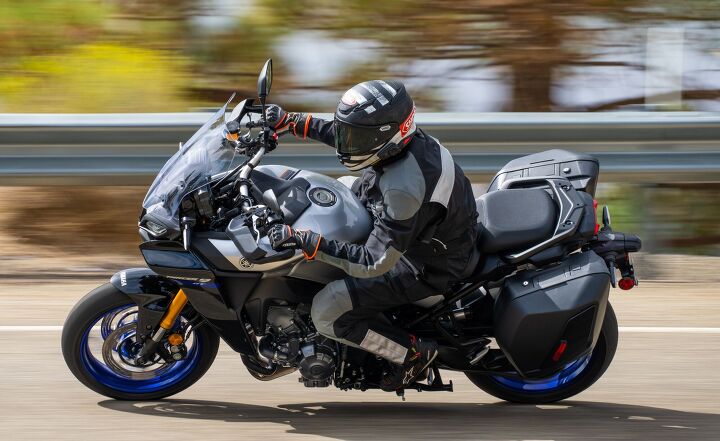
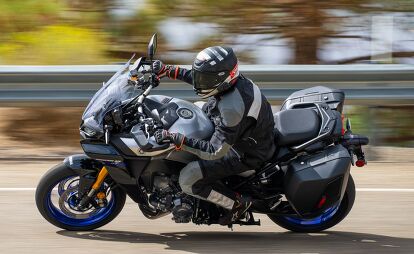

































































































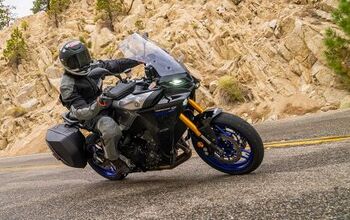


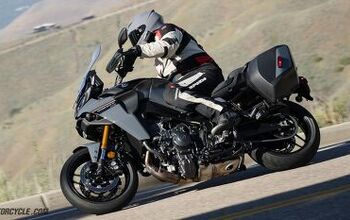
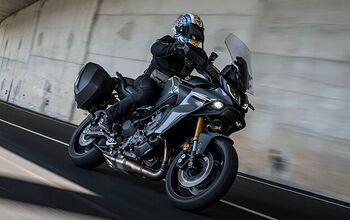










Comments
Join the conversation
I remember back when Yamahas had the best styling of the Big 4 by miles. So many beautiful designs. Now it's fugly on fugly on fugly.
515 lbs with bags at 100 hp at the rear wheel, and what is with that throttle delay? 0-60 time? Why buy this?